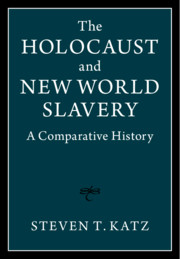Book contents
- The Holocaust and New World Slavery
- The Holocaust and New World Slavery
- Copyright page
- Dedication
- Contents
- Tables
- Preface
- Introduction
- 1 Understanding Black Slavery in the New World
- 2 The Middle Passage
- 3 Considering Slave Demography in the New World
- 4 Reproduction and Miscegenation
- 5 Breeding
- 6 The Conditions of Bondage: Basic Necessities
- 7 The Conditions of Bondage: Beyond Basic Necessities
- 8 Manumission
- 9 American Slave Law
- 10 Black Slavery and the Holocaust: Comparing the Fate of Women and Children
- 11 German Labor Needs and the Murder of Jewish Men and Women
- 12 Devaluing Jewish Labor
- 13 Rape and Rassenschande during the Holocaust
- 14 Murdering Jewish Children
- Conclusion
- Bibliography
- Index
- References
Bibliography
Published online by Cambridge University Press: 09 May 2019
- The Holocaust and New World Slavery
- The Holocaust and New World Slavery
- Copyright page
- Dedication
- Contents
- Tables
- Preface
- Introduction
- 1 Understanding Black Slavery in the New World
- 2 The Middle Passage
- 3 Considering Slave Demography in the New World
- 4 Reproduction and Miscegenation
- 5 Breeding
- 6 The Conditions of Bondage: Basic Necessities
- 7 The Conditions of Bondage: Beyond Basic Necessities
- 8 Manumission
- 9 American Slave Law
- 10 Black Slavery and the Holocaust: Comparing the Fate of Women and Children
- 11 German Labor Needs and the Murder of Jewish Men and Women
- 12 Devaluing Jewish Labor
- 13 Rape and Rassenschande during the Holocaust
- 14 Murdering Jewish Children
- Conclusion
- Bibliography
- Index
- References
- Type
- Chapter
- Information
- The Holocaust and New World SlaveryA Comparative History, pp. 689 - 836Publisher: Cambridge University PressPrint publication year: 2019



